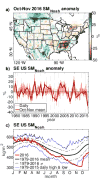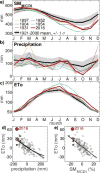The 2016 southeastern US drought: an extreme departure from centennial wetting and cooling
- PMID: 29780677
- PMCID: PMC5956230
- DOI: 10.1002/2017JD027523
The 2016 southeastern US drought: an extreme departure from centennial wetting and cooling
Abstract
The fall 2016 drought in the southeastern United States (SE US) appeared exceptional based on its widespread impacts, but the current monitoring framework that only extends from 1979-present does not readily facilitate evaluation of soil-moisture anomalies in a centennial context. A new method to extend monthly gridded soil-moisture estimates back to 1895 is developed, indicating that since 1895, October-November 2016 soil moisture (0-200 cm) in the SE US was likely the second lowest on record, behind 1954. This severe drought developed rapidly and was brought on by low September-November precipitation and record-high September-November daily maximum temperatures (Tmax). Record Tmax drove record-high atmospheric moisture demand, accounting for 28% of the October-November 2016 soil-moisture anomaly. Drought and heat in fall 2016 contrasted with 20th-century wetting and cooling in the region, but resembled conditions more common from 1895-1956. Dynamically, the exceptional drying in fall 2016 was driven by anomalous ridging over the central United States that reduced south-southwesterly moisture transports into the SE US by approximately 75%. These circulation anomalies were likely promoted by a moderate La Niña and warmth in the tropical Atlantic, but these processes accounted for very little of the SE US drying in fall 2016, implying a large role for internal atmospheric variability. The extended analysis back to 1895 indicates that SE US droughts as strong as the 2016 event are more likely than indicated from a shorter 60-year perspective, and continued multi-decadal swings in precipitation may combine with future warming to further enhance the likelihood of such events.
Figures












References
-
- Ahillen S. Knoxville News Sentinel. Knoxville, TN: 2016. A month after historic fire, Gatlinburg rebuilds. December 28 2016 http://www.knoxnews.com/story/news/local/tennessee/2016/12/28/month-afte...
-
- Allen RG, Pereira LS, Raes D, Smith M. Crop evapotranspiration-Guidelines for computing crop water requirements-FAO Irrigation and drainage. Food and Agriculture Organizatoin of the United Nations; Rome: 1998. p. 15. paper 56. http://www.fao.org/docrep/x0490e/x0490e07.htm - radiation.
-
- Baidya Roy S, Hurtt GC, Weaver CP, Pacala SW. Impact of historical land cover change on the July climate of the United States. Journal of Geophysical Research: Atmospheres. 2003;108(D24) doi: 10.1029/2003JD003565. - DOI
-
- Berg A, Sheffield J, Milly PCD. Divergent surface and total soil moisture projections under global warming. Geophysical Research Letters. 2016;44(1):236–244. doi: 10.1002/2016GL071921. - DOI
Grants and funding
LinkOut - more resources
Full Text Sources
Other Literature Sources
